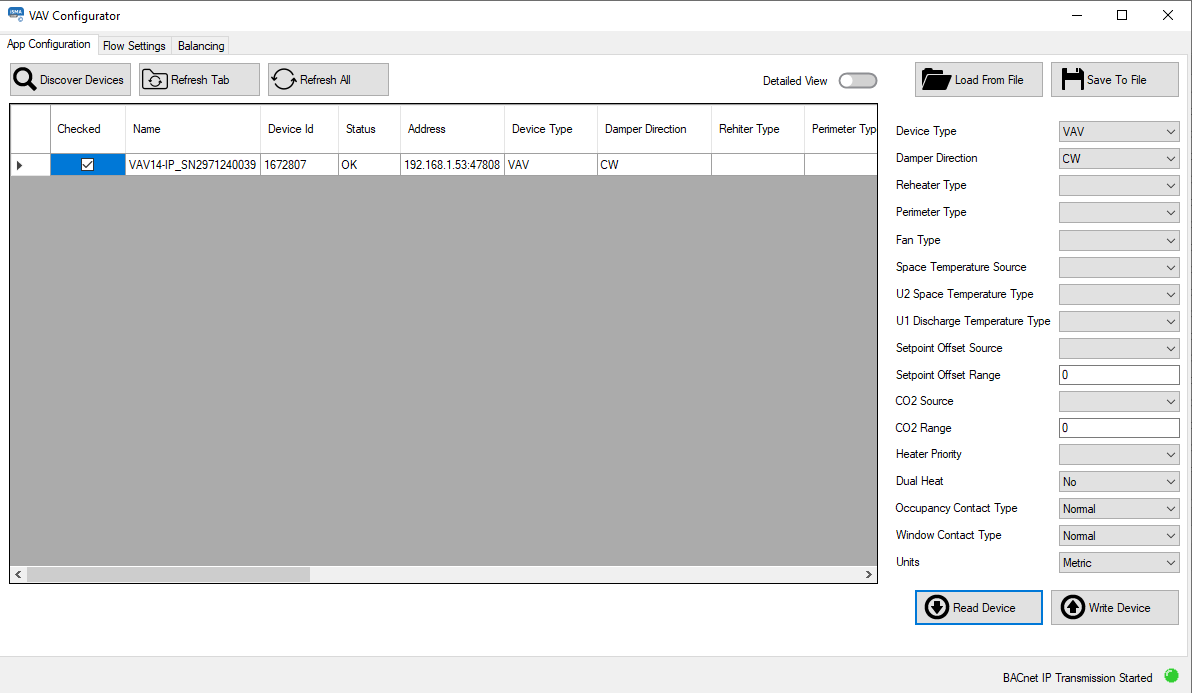App Configuration
The first tab of the VAV Configurator is the App Configuration tab. Here, it is possible to execute four basic actions and configure VAV application parameters.

App Configuration view
The four available actions are:
Load From File: allows to upload application parameters from a previously saved file (*.json);
Save To File: allows to save current application settings to a .json file;
Read Device: reads current application settings directly from the device;
Write Device: sends new settings to the device.
Warning!
Please note that if the switch 1 on the S3 DIP switch is on, the Write Device action will take no effect.
The VAV application parameters available to configure are:
Device Type: allows to choose a device type (DeviceType):
Available settings: VAV (volume air variable - control based on airflow demand) and VVT (variable volume and temperature - control based directly on heating and cooling demands);
Damper Direction: allows to set a damper moving direction to clockwise or counterclockwise (DamperDirection);
Reheater Type: allows to set a reheater type;
Available settings: none, TimeProp (PWM), staged, float;
Perimeter Type: allows to set a perimeter type;
Available settings: none, TimeProp (PWM), digital;
Fan Type: allows to set a fan type;
Available settings: none, series (works only as ventilator regardless of the heating/cooling demand, in occupied or standby statuses), parallel (works on heating demand in the HVAC mode set to Auto or Heat, regardless of the occupancy status);
Space Temperature Source: allows to set a leading source for temperature measurement for the space temperature control loop calculations;
Available settings: panel (Control Point VAV), input (U2), network;
U2 Space Temperature Type: allows to set a space temperature sensor type on the universal input 2;
Available settings: voltage measurement, current, resistance input, specific temperature sensor;
U1 Discharge Temperature Type: if connected, allows to set a discharge temperature sensor type on the universal input 1 (used in the supply air temperature control loop calculations);
Available settings: voltage measurement, current, resistance input, specific temperature sensor;
Setpoint Offset Source: allows to set a source for temperature setpoint offset settings;
Available settings: panel (Control Point VAV), input (U3), network;
Setpoint Offset Range: allows to set a range for setpoint offset settings;
CO2 Source: allows to set a leading source for CO2 measurement for the CO2 control loop calculations;
Available settings: panel (Control Point VAV), input (U4), network;
CO2 Range: allows to set a range for CO2 alarm settings – outside this range the CO2 alarm state will be invoked;
Heater Priority: allows to select a first priority heat source in the DualHeat function for the reheater and perimeter (if used in the system);
Available settings: reheater, perimeter, simultaneous;
Dual Heat: allows to enable a possibility to use one or two heat sources (reheater and perimeter, if used in the system);
Available settings: no, yes;
DualHeat
The DualHeat function allows to select one or two stages of heating (two stages of heating meaning heating with a reheater and, optionally, perimeter and a damper). The DualHeat function is activated according to the setting of the HeatDamperPriority Data Point (linked to the Heat Priority slot in the DamperControlComponent):
primary (false): damper in the range of 0-50% (directly from the space temperature heating loop) and heater(s) in the range of 50-100% (indirectly from the discharge temperature heating loop and directly from the space temperature heating loop),
secondary (true): heater(s) in the range of 0-50% (indirectly from the discharge temperature heating loop and directly from the space temperature heating loop) and damper in the range of 50-100% (directly from the space temperature heating loop).
Heater(s) in the primary stage can be reheater and/or perimeter. If available in the system and properly configured, they can be arranged in order according to the HeaterPriority variable (ReheaterControl folder):
reheater/perimeter
perimeter/reheater
simultaneous.
If there is no reheater and/or perimeter in the system, the DualHeat function cannot be activated and the damper is the only heating source. If the reheater is available in the system, it can be configured as the primary stage heater and the DualHeat function can be activated. However, if the system is equipped with the reheater and parallel fan, the reheater will always be the secondary:
parallel fan/reheater.
Occupancy Contact Type: allows to select an occupancy contact type;
Available settings: normal, invert;
Normal/invert Modes
If available, the motion detector is connected to the I1 digital input. It is possible to choose between two types of a presence sensor operation:
normal (default): I1 true - presence detected, I2 false - no presence detected,
invert: I2 true - no presence detected, I2 false - presence detected.
Window Contact Type: allows to select a mode window reed switch operation;
Available settings: normal, invert;
Normal/invert Modes
If available, the window reed switch is connected to the I2 digital input. It is possible to choose between two types of a reed switch operation:
normal (default): I2 true - window open, I2 false - window closed,
invert: I2 true - window closed, I2 false - window open.
Units: allows to select a units system;
Available settings: imperial, metric.
